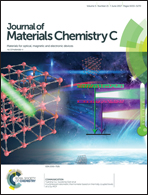Improved efficiency of blue polymer light-emitting diodes using a hole transport material†
Abstract
We developed an efficient hole transport layer by blending the hole transport molecule, N-([1,1′-biphenyl]-4-yl)-9,9-dimethyl-N-(4-(9-phenyl-9H-carbazol-3-yl)-phenyl)-9H-fluoren-2-amine (BCFN), into the classical hole transport polymer, poly(9-vinylcarbazole) (PVK). BCFN has an appropriate highest occupied molecular orbital energy level and high hole mobility, which can simultaneously reduce the hole injection barrier and facilitate hole transportation. It also has excellent miscibility with PVK and can form a uniform and robust film. A device based on a PVK : BCFN blend film with an optimized weight ratio of 3 : 7 as the hole transport layer and the use of the blue light-emitting polymer poly[(9,9-dioctyl-2,7-fluorene)-co-(dibenzothiophene-S,S-dioxide)] (PFSO) as the emissive layer exhibited a maximum luminous efficiency of 7.5 cd A−1 with CIE coordinates of (0.16, 0.15) and very slow efficiency roll-off. The performance of the device was significantly enhanced relative to those without a hole transport layer or with PVK as the hole transport layer. It is of particular interest that the device based on PVK:BCFN showed very stable electroluminescence spectra, which remained nearly identical when the driving voltage was increased from 5 to 15 V. These observations indicate that the newly developed PVK:BCFN can be an effective hole transport layer for the construction of highly efficient blue polymer light-emitting diodes.



 Please wait while we load your content...
Please wait while we load your content...